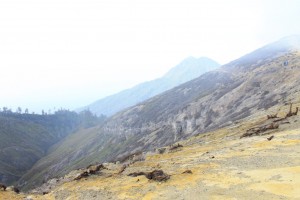Ijen Crater Indonesia
Ijen Crater Indonesia
The Ijen volcano complex is a group of stratovolcanoes in the Banyuwangi Regency of East Java, Indonesia. It is inside a larger caldera Ijen, which is about 20 kilometers wide. The Gunung Merapi stratovolcano is the highest point of that complex. The name “Merapi” means “mountain of fire” in the Indonesian language. Mount Merapi in central Java and Marapi in Sumatra have the same etymology.
West of Gunung Merapi is the Ijen volcano, which has a one-kilometer-wide turquoise colored acid crater lake. The lake is the site of a labor-intensive sulfur mining operation, in which sulfur-laden baskets are carried by hand from the crater floor. The work is low-paid and very onerous. Workers earn around Rp 50,000 – 75,000 ($5.50-$8.30) per day and once out of the crater, still need to carry their loads of sulfur chunks about three kilometers to the near by Paltuding Valley to get paid.
Many other post-caldera cones and craters are located within the caldera or along its rim. The largest concentration of post-caldera cones run east-west across the southern side of the caldera. The active crater at Kawah Ijen has a diameter of 722 metres (2,369 ft) and a surface area of 0.41 square kilometres (0.16 sq mi). It is 200 metres (660 ft) deep and has a volume of 36 cubic hectometres (29,000 acre·ft).
The lake is recognised as the largest highly acidic crater lake in the world. It is also a source for the river Banyupahit, resulting in highly acidic and metal-enriched river water which has a significant detrimental effect on the downstream river ecosystem. In 2008, explorer George Kourounis took a small rubber boat out onto the acid lake to measure its acidity. The pH of the water in the crater was measured to be 0.5 due to sulfuric acid.
For further information, please feel free to contact us balijavaholidays@gmail.com
